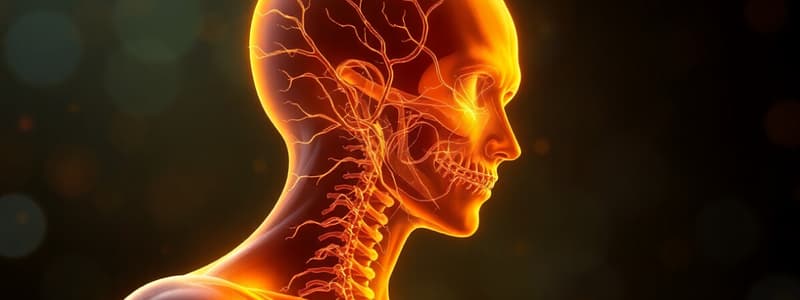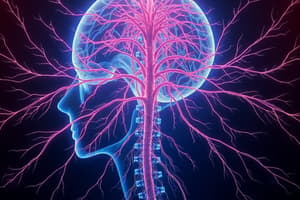Podcast
Questions and Answers
Each spinal nerve, including C1, has a specific cutaneous sensory distribution.
Each spinal nerve, including C1, has a specific cutaneous sensory distribution.
False (B)
Which of the following cranial nerves is responsible for vision?
Which of the following cranial nerves is responsible for vision?
- Olfactory
- Oculomotor
- Optic (correct)
- Trochlear
Cranial nerves are designated with ______ numerals.
Cranial nerves are designated with ______ numerals.
roman
What are the three types of cranial nerves based on their function?
What are the three types of cranial nerves based on their function?
Match the following cranial nerves with their primary functions:
Match the following cranial nerves with their primary functions:
Cranial nerves III, IV, VI, XI, and XII are all motor nerves.
Cranial nerves III, IV, VI, XI, and XII are all motor nerves.
Which cranial nerve is responsible for taste sensation in the anterior 2/3 of the tongue?
Which cranial nerve is responsible for taste sensation in the anterior 2/3 of the tongue?
What is the function of the trigeminal nerve (V)?
What is the function of the trigeminal nerve (V)?
Which of the following is NOT a component of the peripheral nervous system (PNS)?
Which of the following is NOT a component of the peripheral nervous system (PNS)?
Thoracic spinal nerves form plexuses.
Thoracic spinal nerves form plexuses.
What type of axons are found in the anterior root of a spinal nerve?
What type of axons are found in the anterior root of a spinal nerve?
The outer covering of a nerve is called the ____.
The outer covering of a nerve is called the ____.
Match the following spinal nerve plexuses with the body regions they primarily supply:
Match the following spinal nerve plexuses with the body regions they primarily supply:
How many pairs of spinal nerves are there in the human body?
How many pairs of spinal nerves are there in the human body?
The posterior root of a spinal nerve contains motor axons.
The posterior root of a spinal nerve contains motor axons.
What is the name of the nerve from the cervical plexus that stimulates the diaphragm?
What is the name of the nerve from the cervical plexus that stimulates the diaphragm?
A bundle of axons is known as a ______.
A bundle of axons is known as a ______.
Which of the following nerves is known to be the longest nerve in the body?
Which of the following nerves is known to be the longest nerve in the body?
Which division of the autonomic nervous system is responsible for the 'fight or flight' response?
Which division of the autonomic nervous system is responsible for the 'fight or flight' response?
The parasympathetic division enhances the body's ability to respond to emergency situations.
The parasympathetic division enhances the body's ability to respond to emergency situations.
What are the two types of fibers in the autonomic motor pathway?
What are the two types of fibers in the autonomic motor pathway?
The hypothalamus and brainstem regulate the ______.
The hypothalamus and brainstem regulate the ______.
Match the following responses with their corresponding division of the autonomic nervous system:
Match the following responses with their corresponding division of the autonomic nervous system:
What is an effect of sympathetic stimulation?
What is an effect of sympathetic stimulation?
Both sympathetic and parasympathetic divisions can supply nerves to the same viscera.
Both sympathetic and parasympathetic divisions can supply nerves to the same viscera.
What physiological changes occur during sympathetic activation?
What physiological changes occur during sympathetic activation?
The ______ division generally promotes digestion and rest.
The ______ division generally promotes digestion and rest.
Which of the following is NOT a characteristic of the sympathetic division?
Which of the following is NOT a characteristic of the sympathetic division?
Flashcards
Peripheral Nervous System (PNS)
Peripheral Nervous System (PNS)
The part of the nervous system outside the brain and spinal cord, including all nerves that connect to the CNS.
Spinal Nerves
Spinal Nerves
Nerves that branch out from the spinal cord and connect it to muscles, sensory receptors, and glands throughout the body. There are 31 pairs, named and numbered based on the region of the vertebral column they emerge from.
Nerve Roots
Nerve Roots
Bundles of nerve fibers that connect the CNS to sensory receptors, muscles, and glands.
Posterior Root
Posterior Root
Signup and view all the flashcards
Dermatome
Dermatome
Signup and view all the flashcards
Anterior Root
Anterior Root
Signup and view all the flashcards
Protective Covering of Spinal Nerves
Protective Covering of Spinal Nerves
Signup and view all the flashcards
Cranial Nerves
Cranial Nerves
Signup and view all the flashcards
Fascicle
Fascicle
Signup and view all the flashcards
Olfactory Nerve (I)
Olfactory Nerve (I)
Signup and view all the flashcards
Optic Nerve (II)
Optic Nerve (II)
Signup and view all the flashcards
Epineurium
Epineurium
Signup and view all the flashcards
Nerve Plexuses
Nerve Plexuses
Signup and view all the flashcards
Oculomotor Nerve (III)
Oculomotor Nerve (III)
Signup and view all the flashcards
Cervical Plexus
Cervical Plexus
Signup and view all the flashcards
Trochlear Nerve (IV)
Trochlear Nerve (IV)
Signup and view all the flashcards
Trigeminal Nerve (V)
Trigeminal Nerve (V)
Signup and view all the flashcards
Abducens Nerve (VI)
Abducens Nerve (VI)
Signup and view all the flashcards
Facial Nerve (VII)
Facial Nerve (VII)
Signup and view all the flashcards
Vestibulocochlear Nerve (VIII)
Vestibulocochlear Nerve (VIII)
Signup and view all the flashcards
Glossopharyngeal Nerve (IX)
Glossopharyngeal Nerve (IX)
Signup and view all the flashcards
Vagus Nerve (X)
Vagus Nerve (X)
Signup and view all the flashcards
Spinal Accessory Nerve (XI)
Spinal Accessory Nerve (XI)
Signup and view all the flashcards
Hypoglossal Nerve (XII)
Hypoglossal Nerve (XII)
Signup and view all the flashcards
What is the Autonomic Nervous System (ANS)?
What is the Autonomic Nervous System (ANS)?
Signup and view all the flashcards
Who is the boss of the ANS?
Who is the boss of the ANS?
Signup and view all the flashcards
What does the ANS control?
What does the ANS control?
Signup and view all the flashcards
Describe the two-neuron pathway of the ANS.
Describe the two-neuron pathway of the ANS.
Signup and view all the flashcards
What does the sympathetic division do?
What does the sympathetic division do?
Signup and view all the flashcards
What does the parasympathetic division do?
What does the parasympathetic division do?
Signup and view all the flashcards
What is the relationship between the sympathetic and parasympathetic divisions?
What is the relationship between the sympathetic and parasympathetic divisions?
Signup and view all the flashcards
What activates the sympathetic system?
What activates the sympathetic system?
Signup and view all the flashcards
Compare the effects of the sympathetic and parasympathetic divisions.
Compare the effects of the sympathetic and parasympathetic divisions.
Signup and view all the flashcards
What are the effects of the parasympathetic division?
What are the effects of the parasympathetic division?
Signup and view all the flashcards
Study Notes
Peripheral Nervous System (PNS)
- The PNS branches from the brain and spinal cord
- It includes all nervous tissue outside the CNS
- Components: spinal nerves, cranial nerves, autonomic nervous system (ANS)
- Spinal nerves: 31 pairs
- Cranial nerves: 12 pairs
- ANS: The autonomic nervous system is not under conscious control and is regulated by the hypothalamus and brainstem
Spinal Nerves
- Spinal nerves and their branches connect to the spinal cord through posterior and anterior roots
- They connect the CNS to parts of the body, including sensory receptors, muscles, and glands.
- 31 pairs of spinal nerves are named and numbered based on their location in the vertebral column
- Each nerve has 8 cervical, 12 thoracic, 5 lumbar, 5 sacral, and 1 coccygeal spinal nerves
- Cervical nerves (C1-C8)
- Thoracic nerves (T1-T12)
- Lumbar nerves (L1-L5)
- Sacral nerves (S1-S5)
- Coccygeal nerve (Co1)
Spinal Nerves: Structure & Function
- Spinal nerve has two connections: posterior root (sensory axon) and anterior root (motor axons).
- The posterior and anterior roots unite to form a spinal nerve (a mixed nerve)
- The posterior root ganglion contains the cell bodies of sensory neurons.
Spinal Nerves: Protective Covering
- Spinal nerves have protective connective tissue coverings
- Endoneurium: wraps a single axon
- Perineurium: wraps a fascicle (bundle of axons)
- Epineurium: the outer covering of a nerve
- Blood vessels are within the perineurium and epineurium, nourishing the nerve tissues.
Spinal Nerves: Plexuses
- Spinal nerves branch after passing through intervertebral foramina.
- In cervical, lumbar, and sacral regions, spinal nerves join with branches from neighboring nerves, forming plexuses.
- Thoracic nerves do not form plexuses
- 5 main plexuses: cervical, brachial, lumbar, sacral, coccygeal
Cervical Plexus
- Supplies posterior head, neck, shoulders, and diaphragm (including the phrenic nerve, crucial for diaphragm function).
- Damage can lead to respiratory failure.
Brachial Plexus
- Supplies upper limbs and some neck and shoulder muscles
- Includes important nerves like radial, ulnar, and median nerves.
Lumbar Plexus
- Supplies abdominal wall, external genitalia, and parts of the lower limbs
- Includes the femoral nerve.
Sacral Plexus
- Supplies buttocks, perineum, and most parts of the lower limbs
- Includes the sciatic nerve, which is the longest and largest nerve in the human body.
Cranial Nerves
- 12 pairs of cranial nerves
- Designated with Roman numerals (I-XII) representing their order as they emerge from the brain
- Cranial nerves I, II, and VIII: sensory nerves
- Cranial nerves III, IV, VI, XI, and XII: motor nerves
- Cranial nerves V, VII, IX, and X: mixed nerves
Cranial Nerves (Functions)
- Olfactory (I): Smell
- Optic (II): Vision
- Oculomotor (III): Eye movement and pupil dilation
- Trochlear (IV): Eye movement
- Trigeminal (V): Somatosensation from face and head; chewing
- Abducens (VI): Eye movement
- Facial (VII): Taste (anterior 2/3 of tongue) and facial muscles
- Vestibulocochlear (VIII): Hearing and balance
- Glossopharyngeal (IX): Taste (posterior 1/3 of tongue) and swallowing muscles
- Vagus (X): Sensory, motor, and autonomic functions for viscera and swallowing
- Accessory (XI): Head movement muscles
- Hypoglossal (XII): Tongue movement
Autonomic Nervous System (ANS)
- The ANS is an important component of the peripheral nervous system (PNS)
- It is not under conscious control and regulates involuntary functions like digestion, heart rate, blood pressure, and other body functions
- Two divisions: sympathetic and parasympathetic
- ANS pathways have two neurons: preganglionic neuron (first neuron), postganglionic neuron (second neuron)
- Preganglionic fiber leaves the CNS and synapses with the second neuron in an autonomic ganglion
- The postganglionic fiber from the ganglion goes to the effector organ.
- The second neuron's cell body is in an autonomic ganglion.
- ANS motor pathways have two neurons
ANS Motor Pathways
- Sympathetic pathways release norepinephrine (NE), and parasympathetic pathways release acetylcholine (ACh).
- ANS regulates glands, smooth muscle, and the heart.
- Examples: Heart rate, breathing rate, blood flow, and digestion
Sympathetic Division (ANS)
- Part of the autonomic nervous system which triggers fight-or-flight responses
- Stimulated during stressful or emergency situations (e.g., exercise, excitement, emergency, embarrassment)
- Causes increased heart rate, breathing rate to skeletal muscles, and decreases activity in the digestive system.
- Longer-lasting effects and more widespread response than parasympathetic
- Release of hormones adrenaline (epinephrine) and noradrenaline into the bloodstream
Parasympathetic Division (ANS)
- Activated when at rest
- Stimulates the rest-and-digest process, decreasing functions like heart rate and increasing functions like digestion
- Effects are less widespread, shorter-lasting than sympathetic responses
Dermatomes
- The skin regions supplied by specific spinal nerves are called dermatomes
- Each spinal nerve (except C1) has a specific cutaneous sensory distribution.
Clinical Disorders
- Traumatic brain injuries (concussion, contusion)
- Strokes
- Alzheimer's disease
- Neural tube defects (e.g., anencephaly, spina bifida)
- Paraplegia
- Quadriplegia
- Myelitis
- Cerebral palsy
- Microcephaly
Studying That Suits You
Use AI to generate personalized quizzes and flashcards to suit your learning preferences.




